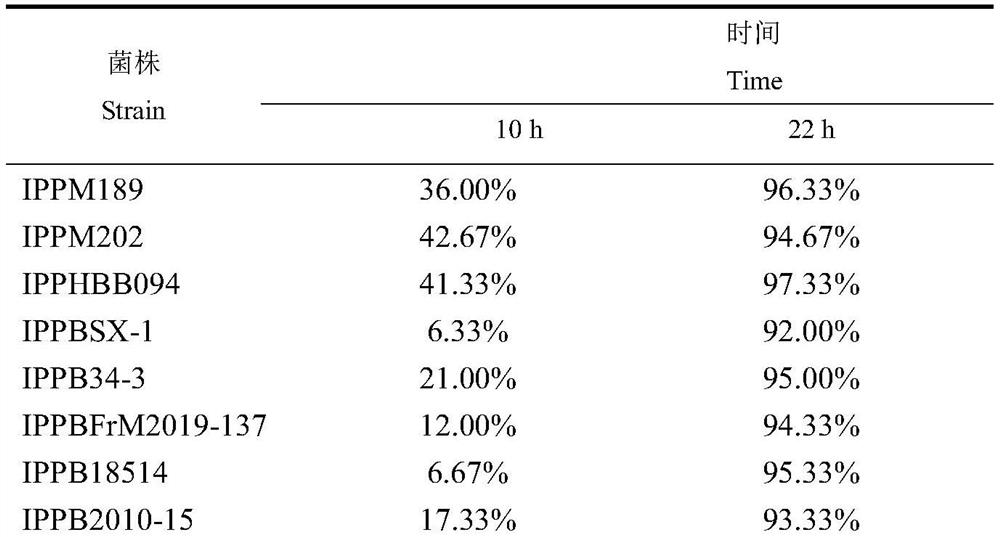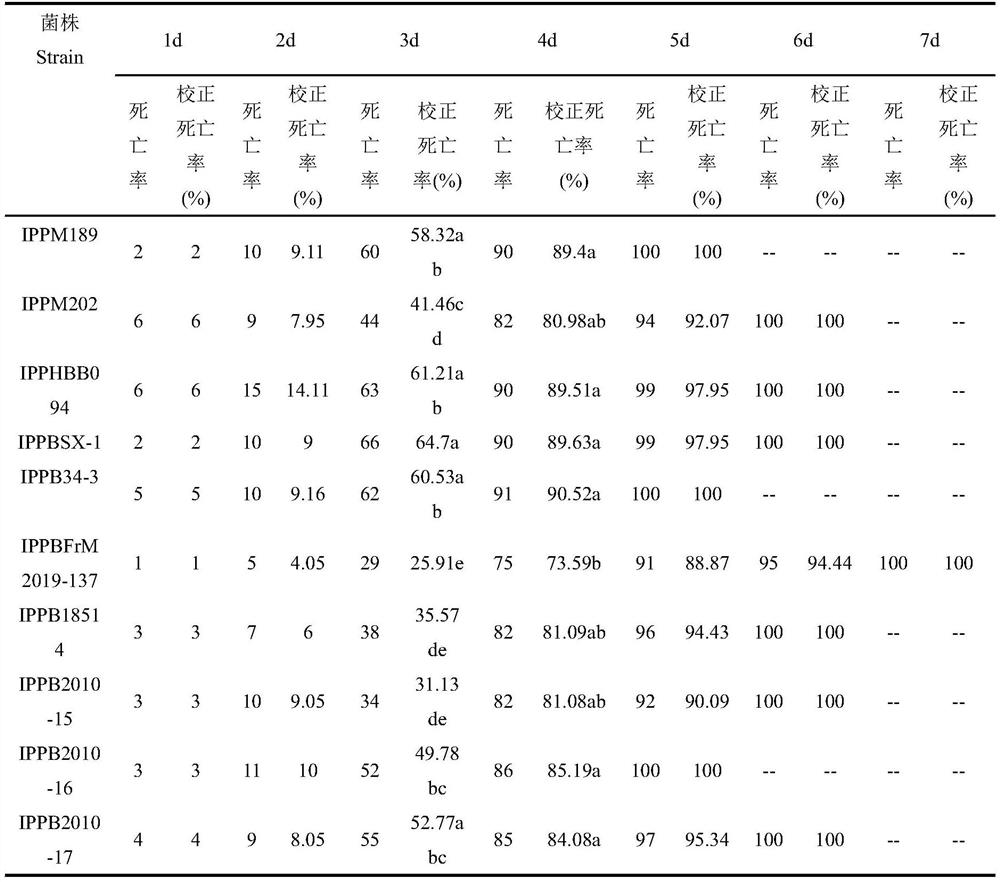A kind of fungal strain and application thereof for controlling alfalfa spotted aphid
A strain, alfalfa technology, applied in the direction of application, fungi, and microbial-based methods, etc., can solve problems such as unreasonable use, and achieve the effects of fast growth, large spore production, and simple cultivation
- Summary
- Abstract
- Description
- Claims
- Application Information
AI Technical Summary
Problems solved by technology
Method used
Image
Examples
Embodiment 1
[0014] Example 1 Isolation of bacterial strains
[0015] The strain was derived from aphid bots collected from the fields in the western suburbs of Haidian District, Beijing. The larvae were transferred to a sterile Petri dish with wet filter paper and kept at 30°C for constant temperature cultivation. After the mycelium grows, pick the apex mycelium with a sterile inoculation loop, inoculate it on a flat plate (PDA medium), purify and cultivate it at a constant temperature of 30° C. to obtain Beauveria bassiana IPPHBB094 of the present invention, and repeat the culture for 2 Store in the laboratory at 4°C after -3 times.
[0016] 1. Tested strains: IPPHBB094, IPPBSX-1, IPPB34-3, IPPB18514, IPPB2010-15, IPPB2010-16, IPPB2010-17, IPPBFrM2019-137, IPPM189, IPPM202 were provided by the Institute of Plant Protection, Chinese Academy of Agricultural Sciences, using PDA The culture medium was separated and purified and stored in the laboratory at 4°C.
[0017] 2. Method: The germ...
Embodiment 2
[0023] Example 2 Toxicity determination of alfalfa spotted aphid population
[0024] 1. Method: inoculate by dipping method, and carry out indoor toxicity test. Use PDA to cultivate each strain at 30°C. After the spore powder covers the entire petri dish, scrape the spore powder with a spore scraper, transfer it into sterile water containing 0.01% Tween-80 to prepare a spore suspension, and place it in a shaker Shake fully on the instrument, measure the spore concentration with a hemocytometer, and dilute to the required concentration (1x10 8 spores / mL).
[0025] 2. Test strains: IPPHBB094, IPPBSX-1, IPPB34-3, IPPB18514, IPPB2010-15, IPPB2010-16, IPPB2010-17, IPPBFrM2019-137, IPPM189, IPPM202 are provided by the Institute of Plant Protection, Chinese Academy of Agricultural Sciences, using PDA The culture medium was separated and purified and stored in the laboratory at 4°C.
[0026] 3. Selection of alfalfa spot aphid for testing: alfalfa spot aphid was collected from Rishe...
Embodiment 3
[0038] The virulence strategy of embodiment 3 different bacterial strain concentrations to the spotted aphid alfalfa population
[0039] 1. Method: inoculate by dipping method, and carry out indoor toxicity test. Use PDA to cultivate each strain at 30°C. After the spore powder covers the entire petri dish, scrape the spore powder with a spore scraper, transfer it into sterile water containing 0.01% Tween-80 to prepare a spore suspension, and place it in a shaker Shake fully on the instrument, measure the spore concentration with a hemocytometer, and dilute to the required concentration (1x10 8 spores / mL).
[0040] 2. Test strains: IPPHBB094, IPPBSX-1, IPPB34-3, IPPM189, IPPM202 were all provided by the Institute of Plant Protection, Chinese Academy of Agricultural Sciences, separated and purified by PDA medium, and stored in the laboratory at 4°C.
[0041] 3. Selection of alfalfa spot aphid for testing: alfalfa spot aphid was collected from Risheng Modern Agriculture Alfalfa...
PUM
 Login to View More
Login to View More Abstract
Description
Claims
Application Information
 Login to View More
Login to View More - Generate Ideas
- Intellectual Property
- Life Sciences
- Materials
- Tech Scout
- Unparalleled Data Quality
- Higher Quality Content
- 60% Fewer Hallucinations
Browse by: Latest US Patents, China's latest patents, Technical Efficacy Thesaurus, Application Domain, Technology Topic, Popular Technical Reports.
© 2025 PatSnap. All rights reserved.Legal|Privacy policy|Modern Slavery Act Transparency Statement|Sitemap|About US| Contact US: help@patsnap.com



